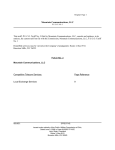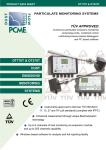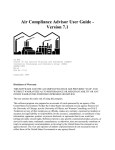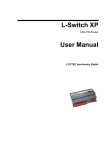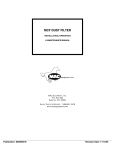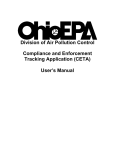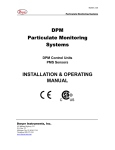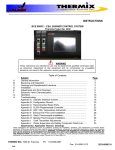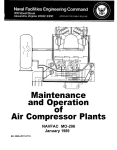Download Operator`s Manual - ARS Recycling Systems
Transcript
ARS Recycling Systems Aries Vac Super Unit: Operation and Maintenance Manual Thank you for choosing ARS Recycling Systems. This manual contains all the important information you will need to know to SAFELY and properly operate, maintain, and store this machine. It includes troubleshooting, electrical and mechanical schematics, as well as original equipment manufacturer (OEM) documentation. Also included is a maintenance checklist for your technicians to use as a guideline when inspecting and servicing the Aries Vac. Please note – This manual contains information for both the diesel-powered and electric powered blowers. Each unit has its own section dedicated to its specific start up and shut down instructions. The information listed in the rest of the manual will apply to both units unless otherwise stated in bold text. We greatly appreciate your business and should you have any questions regarding this machine, please do not hesitate to contact us at: ARS Recycling Systems, LLC. 4000 McCartney Road, Lowellville OH 4436-9510 PHONE: (330)536-8210 FAX: (330)536-8211 AV Standard Service Manual Rev 0 ARS Recycling Systems Index: General Safety Start Up and Shut Down Instructions Pre-Start Up Start Up Instructions Diesel Powered Unit Start Up Electric Powered Unit Start Up Shut Down Instructions Diesel Powered Unit Shut Down Electric Powered Unit Shut Down Service and Maintenance Storage Guidelines Trouble Shooting Electrical Device List Drawings – Pneumatic Schematic (11771), Electrical, Blastpot Circuit (11056) OEM Documentation: Desiccant Dryer and Aftercoolers Bucket Elevator Vibrating Tray Blower Blower Diesel Engine and Display Generator Power Take-Off (PTO) Coupling Trailer Blast System Low-vac Fan Magnetic Drum *Section 8.08 intentionally left blank. AV Standard Service Manual Rev 0 Section: 1.00 2.00 2.10 2.21 2.22 2.31 2.32 3.00 4.00 5.00 6.00 7.00 8.01 8.02 8.03 8.04 8.05 8.06 8.07 8.08* 8.09 8.10 8.11 8.12 8.13 ARS Recycling Systems 1.00 - General Safety CAUTION: Improper use of this machine and the failure to follow any and all safety instructions can result in property damage, serious injury or death. Only individuals with proper training should operate or perform maintenance on this machine. Safety instructions must be thoroughly read and subsequently followed at all times. Under no circumstances should an individual use or be allowed to use the equipment without first receiving thorough instruction. Ensure that all whip devices (retaining devices) are in place on all hoses connected to the machine. Proper hearing and eye protection be worn during operation. Safe Operation Guidelines: a. Transporting the unit while it is filled with abrasives or waste will void any warranties. b. High voltages are present at power terminals of this unit. Contact with such terminals will result in highly dangerous and possibly lethal electric shock. c. Engine exhaust may cause sickness or death. Operate in a ventilated area only. d. Engine exhaust is hot. Avoid contact with exhaust parts. e. Unit contains one or more powerful magnetic circuits. Individuals with a pacemaker or similar device must never approach the equipment. The resulting magnetic field may cause pacemakers to malfunction. f. Diesel fuel is highly flammable. Do not refuel while the engine is running and avoid contact with open flames or sparks. g. Wear protective equipment: protective clothing, hearing protection, respirator, safety glasses h. Battery gases can explode. Keep sparks and open flames away from the top of the battery. i. Remove all jewelry and rings to prevent electrical shorts and entanglement in moving parts. j. Keep body parts and clothing (especially loose clothing, neckties, and scarves) away from moving parts and vacuum openings. k. Unit must be grounded to the earth. l. Avoid all pinch points. m. Dispose of waste properly. AV Standard Service Manual Rev 0 ARS Recycling Systems 1.01 - List of Safety Features: 1.) Emergency Stops (qty: 3-4) - Located on 3 sides of the unit. Main control Panel Rear of the unit Side of the rock box AV Standard Service Manual Rev 0 ARS Recycling Systems 1.01 - List of Safety Features: NOTE – For Electric powered units, there is an additional Emergency stop located on the electric control panel (pictured below): 2.) Vacuum Break (qty: 2) – Located on 2 sides of the unit Near the blower engine control panel. Exact position of this vacuum break may vary. Side of the rock box AV Standard Service Manual Rev 0 ARS Recycling Systems 1.01 – List of Safety Features 3.) Vacuum Break Remote Pendant and Cord – See section 6.07 4.) 12-Volt Outlets for remote deadman switch. 5.) Grounding Lug – For earth grounding of the unit. Located on the generator housing (pictured below). 6.) Vacuum Safety Fittings for 4” Vacuum Hose – 3-4” safety fittings provided 7.) Interlock Power Failure System – Internal components that will shut down the blower system in the event of an electrical failure. 8.) Handrails and chain - Provided for the top of the storage bin (pictured below). AV Standard Service Manual Rev 0 ARS Recycling Systems 2.10 – Pre-Start Up Instructions 1. Recycler should be leveled on firm ground with drive legs extended. 2. The main breaker on the main control panel must be OFF. 3. Check engine oil level and the coolant level on both the diesel engine and generator. For more information, refer to sections 8.05 – Blower Diesel Engine and 8.06 – Generator. 4. FOR DIESEL-POWERED UNIT ONLY: Grease the topmost bearing on the PTO bell housing with one pump after every 16 hours of operation. For the 3 remaining bearings, lubricate them with one pump after every 40 hours of operation. AV Standard Service Manual Rev 0 ARS Recycling Systems 2.10 – Pre-Start Up Instructions 5. FOR DIESEL-POWERED UNIT ONLY: Check to see if clutch is disengaged. Pictured below is a clutch in the disengaged position. 6. Check blower oil level via the sight gauges. The oil level should be in the middle of the gauge and the oil itself should have a golden color. AV Standard Service Manual Rev 0 ARS Recycling Systems 2.10 – Pre-Start Up Instructions 7. Using the various service doors located throughout the unit, inspect all major components for grit and moisture. All grit should be removed from the system. Note that if the system has been idle, hardened grit could be present in these areas. Caution: To avoid breathing in harmful dust and debris, it is STRONGLY advised that proper respiratory equipment is used when performing this task. Double Dump Vibrating Tray Rock Box Magnetic Drum AV Standard Service Manual Rev 0 Bucket Elevators Blast Pots ARS Recycling Systems 2.10 – Pre-Start Up Instructions 8. Walk around the unit and visually inspect for leaks (oil, fluid). Ensure that all valves are closed (valve handle is perpendicular to the pipe or fitting). These valves include: Air Supply Valves Desiccant tank inlet valves All Blast Pot Valves Desiccant drain valves (under tanks) Hi and Low-Vac bag house Valves 9. Make sure that all emergency stops are pulled out. There are three on the unit. Main Control Panel Side of the Rock Box AV Standard Service Manual Rev 0 Rear of the unit ARS Recycling Systems 2.10 – Pre-Start Up Instructions 10. Check engine air filter restriction gauge (pictured below) and ensure that it is in place and intact. When the unit is on, the gauge will indicate a clogged filter. 11. The vac break manual override should be switched to OPEN. There are two on the Diesel-powered units but only one (the vac break by the rock box) equipped on Electric-powered units: Side of the engine control panel Side of the rock box 12. Connect the air-compressor supply line and retaining devices (whip devices). Start the air supply and SLOWLY open the inlet valve. . AV Standard Service Manual Rev 0 ARS Recycling Systems 2.10 – Pre-Start Up Instructions When the compressor is running and the valve is open, the gauge located at the rear of the unit will read the amount of air pressure that the compressor is putting out (the minimum required reading is 125 PSI). AV Standard Service Manual Rev 0 ARS Recycling Systems 2.21 Diesel Powered Unit Start-Up Instructions 1. After making sure that the clutch is disengaged, vacuum break is open, and recycler has sufficient fuel, go over to the motor control panel and turn the ignition switch clockwise from the OFF position to the ON position (pictured below). 2. A red and yellow light on top of the motor control panel (pictured above) should turn on. The lights should turn off in a few seconds. After the lights are off, turn the ignition switch clockwise from the ON position to the START position (pictured below) to start the diesel engine. NOTE: The ignition switch is spring-loaded and will snap back to the START position once the engine has been turned on. 3. Once started, let the engine idle for 5-10 minutes allowing the engine to reach operating temperature. Then press the RABBIT button on the throttle until the speed of 1000 RPM is reached. AV Standard Service Manual Rev 0 ARS Recycling Systems 2.21 Diesel Powered Unit Start-Up Instructions 4. Engage PTO by pulling the handle forward. 5. Once the clutch is engaged, allow the blower to warm up for 5 minutes. 6. Press the RABBIT button on the throttle until the speed of 1800 RPM is reached. To begin vacuuming: 7. Make sure vacuum hoses are open to safe areas. 8. Close the vacuum break. The vacuum gauge should now begin reading. After closing the vacuum break, ensure that the RPM on the engine control panel is still at 1800. If not, press the rabbit button until the RPM is back to 1800. 9. Open the generator housing and start the generator by setting the generator switch to ON. Next, turn on the RUN button. AV Standard Service Manual Rev 0 ARS Recycling Systems 2.21 Diesel Powered Unit Start-Up Instructions 10. Then, flip the main breaker to ON. 11. Go to the main control panel. AV Standard Service Manual Rev 0 ARS Recycling Systems 2.21 Diesel Powered Unit Start-Up Instructions 12. Turn main breaker ON 13. Press start on control panel button #1 Baghouse Fan. Allow the baghouse fan a few seconds to reach its proper RPM. 14. Press start on control panel button #2 Bucket Elevator #2. This will also activate the storage bin auger. 15. Press start on control panel button #3 Vibratory Tray. 16. Press start on control panel button #4 Magnetic Drum. 17. Turn and hold the safety override switch to the start position. The safety override switch will bypass the zero speed sensor (see section 6.04) and allow the bucket elevator to be started. While holding the safety override switch to the start position, press start on button #5 Bucket Elevator #1. Once the elevator is running, the Motor Fault light (pictured below) will shut off. You can now release the safety override switch. AV Standard Service Manual Rev 0 ARS Recycling Systems 2.21 Diesel Powered Unit Start-Up Instructions 18. Press start on button #6 Pulsation system. 19. Press start on button #7 Double Dump. 20. The display panel should now read “All Functions Normal” To begin blasting: 21. Once the vacuum is engaged, check to see if the air wash gauge (on the Main Control panel) is adjusted to 1” of water. To adjust the gauge, turn the handle located above the main control panel and to the right. 22. Again, ensure that all hoses are attached to the blast pots and safety devices are in place. AV Standard Service Manual Rev 0 ARS Recycling Systems 2.21 Diesel Powered Unit Start-Up Instructions 23. Ensure that desiccant drain valves are slightly open. This will allow moisture to continually drain out during operation, leaving the unit via the hoses in the back. CAUTION: Follow any regulations on the disposal of this water. 24. Turn the ball valve handles under the pots (near the Thompson II valve) DOWNWARDS to allow abrasives to flow. If the handle remains in position, only air will flow. AV Standard Service Manual Rev 0 ARS Recycling Systems 2.21 Diesel Powered Unit Start-Up Instructions 25. On the blast pots, set the ball valves (both the 2.5” and the 1.5”) to open by turning the handles from the perpendicular position to the parallel position. NOTE - Pictured above is the Auto/Manual air valve in the MANUAL (up) position. In AUTO position, the blast pot will depressurize the instant a blaster comes off his nozzle. If a blaster is frequently repositioning himself, he may be on and off his nozzle in rapid succession. This results in unnecessary pot-depressurization. By moving this valve to the MANUAL position, the pot will stay pressurized until the valve is shifted back to AUTO. AV Standard Service Manual Rev 0 ARS Recycling Systems 2.21 Diesel Powered Unit Start-Up Instructions 26. Press start on Main Control Panel button #8 Blast System. 27. Press start on Main Control Panel button #9 After Cooler #1. 28. Press start on Main Control Panel button #10 After Cooler #2. AV Standard Service Manual Rev 0 ARS Recycling Systems 2.22 – Electric Powered Unit Start-Up 1. Go over to the Electric Control Panel 2. Connect power supply to the Electric control panel (see below) 3. Turn power supply ON. AV Standard Service Manual Rev 0 ARS Recycling Systems 2.22 – Electric Powered Unit Start-Up To begin vacuuming 4. Make sure that vacuum hoses are open to safe areas. 5. Go over to the vacuum break by the rock box and ensure that it is OPEN. Note – This is the only vacuum break switch equipped on the Electric AV units. 6. Turn the Electric Control panel breaker from the OFF position to the ON position (pictured below) AV Standard Service Manual Rev 0 ARS Recycling Systems 2.22 – Electric Powered Unit Start-Up 7. At this point the Main power light and the Blower Disabled light should turn on. 8. Turn the Blower Safety Override switch (pictured below) to the ENABLE position and hold for about 3 seconds. 9. At the point the Blower Disabled light should turn OFF and the Blower Standby light should turn ON. AV Standard Service Manual Rev 0 ARS Recycling Systems 2.22 – Electric Powered Unit Start-Up 10. Push the Blower START button and hold for about three seconds. 11. At this point, the Blower Standby light should go out and the Blower Ready light should turn ON. 12. Go to the main control panel. AV Standard Service Manual Rev 0 ARS Recycling Systems 2.22 – Electric Powered Unit Start-Up 13. Press start on control panel button #1 Baghouse Fan. Allow the baghouse fan a few seconds to reach its proper RPM. 14. Press start on control panel button #2 Bucket Elevator #2. This will also activate the storage bin auger. 15. Press start on control panel button #3 Vibratory Tray. 16. Press start on control panel button #4 Magnetic Drum. 17. Turn and hold the safety override switch to the start position. The safety override switch will bypass the zero speed sensor (see section 6.04) and allow the bucket elevator to be started. While holding the safety override switch to the start position, press start on button #5 Bucket Elevator #1. Once the elevator is running, the Motor Fault light (pictured below) will shut off. You can now release the safety override switch. 18. Press start on control panel button #6 Pulsation System. 19. Press start on control panel button #7 Double Dump. 20. The display panel should now read “All Functions Normal” AV Standard Service Manual Rev 0 ARS Recycling Systems 2.22 – Electric Powered Unit Start-Up To begin blasting: 21. Once the vacuum is engaged, check to see if the air wash gauge (on the Main Control panel) is adjusted to 1” of water. To adjust the gauge, turn the handle located above the main control panel and to the right. 22. Again, ensure that all hoses are attached to the blast pots and safety devices are in place. AV Standard Service Manual Rev 0 ARS Recycling Systems 2.22 – Electric Powered Unit Start-Up 23. Ensure that desiccant drain valves are slightly open. This will allow moisture to continually drain out during operation, leaving the unit via the hoses in the back. CAUTION: Follow any regulations on the disposal of this water. 24. Turn the ball valve handles under the pots (near the Thompson II valve) DOWNWARDS to allow abrasives to flow. If the handle remains in position, only air will flow. AV Standard Service Manual Rev 0 ARS Recycling Systems 2.22 – Electric Powered Unit Start-Up 25. On the blast pots, set the ball valves (both the 2.5” and the 1.5”) to open by turning the handles from the perpendicular position to the parallel position. NOTE - Pictured above is the Auto/Manual air valve in the MANUAL (up) position. In AUTO position, the blast pot will depressurize the instant a blaster comes off his nozzle. If a blaster is frequently repositioning himself, he may be on and off his nozzle in rapid succession. This results in unnecessary pot-depressurization. By moving this valve to the MANUAL position, the pot will stay pressurized until the valve is shifted back to AUTO. 26. Press start on Main Control Panel button #8 Blast System. 27. Press start on Main Control Panel button #9 After Cooler #1. 28. Press start on Main Control Panel button #10 After Cooler #2. AV Standard Service Manual Rev 0 ARS Recycling Systems 2.31 – Diesel Powered Unit Shut Down 1. When vacuuming is finished, allow machine to run for 15 min. to allow grit and debris to empty. 2. Press the turtle button on the engine control panel until a speed of 1000 RPM is reached. 3. When the engine stabilizes, disengage the PTO: 4. Then, press the turtle button again to lower the engine RPM to 800 RPM. Allow the engine to idle for 10-15 minutes so that it can cool down. 5. Press stop on button #7 Double Dump. 6. Press stop on button #5 Bucket Elevator #1. 7. Press stop on button #4 Magnetic Drum. 8. Press stop on button #3 Vibrating Tray. AV Standard Service Manual Rev 0 ARS Recycling Systems 2.31 – Diesel Powered Unit Shut Down 9. Press stop on button #2 Bucket Elevator #2. 10. Press stop on button #1 Baghouse Fan. 11. Up until this point, button #6 Pulsation System has been left on in order to clean the baghouses. Once the pulsation system has been left on for about 5-10 minutes, press stop on button #6. 12. It is now safe to shut down the generator. To do this, open the generator housing and turn the switch on the generator control panel to the OFF position. Then, flip the main breaker to OFF. 13. When the system is shut down, check all inspection and clean-out doors and remove any remaining grit and debris. Do not allow spent abrasive to remain in the system. AV Standard Service Manual Rev 0 ARS Recycling Systems 2.32 - Electric Powered Unit Shut Down 1. Allow machine to run for 15 min. to allow grit and debris to empty. Next, go over to the Main Control Panel and perform the following steps in the sequence in which they are listed: 2. Open the vacuum break by the rock box 3. Press stop on button #7 Double Dump. 4. Press stop on button #5 Bucket Elevator #1. 5. Press stop on button #4 Magnetic Drum. 6. Press stop on button #3 Vibrating Tray. 7. Press stop on button #2 Bucket Elevator #2. 8. Press stop on button #1 Baghouse Fan. 9. Up until this point, button #6 Pulsation System has been left on in order to clean the baghouses. Once the pulsation system has been left on for about 5-10 minutes, press stop on button #6. 10. Go over to the Electric control panel and press the Blower STOP button. AV Standard Service Manual Rev 0 ARS Recycling Systems 2.32 - Electric Powered Unit Shut Down 11. Turn the Blower Safety Override to the DISABLE position. 12. When the system is shut down, check all inspection and clean-out doors and remove any remaining grit and debris. Do not allow spent abrasive to remain in the system. AV Standard Service Manual Rev 0 ARS Recycling Systems 3.00 – Service and Maintenance CAUTION: Before performing any maintenance on this unit, the recycler and air compressor must NOT be running. All hoses must be disconnected. After maintenance has been performed, all hoses connected to the machines must have retaining devices in place. Hearing and eye protection should be worn during operation. 3.01 - Aftercoolers 1. Check for excessive dirt build-up on fins. 2. For core cleaning, motor lubrication, and a list of replacement parts, please refer to section 8.01 Desiccant Dryers and Aftercoolers Aftercooler OEM. 3.02 - Desiccant Dryers 1. Check salt level using the sight gauge (pictured below, gauge might be obscured on the unit) For more information and refilling instructions, refer to section 8.01 Desiccant Dryers and Aftercoolers Desiccant Tank OEM. 2. Check hatch gaskets when inspecting levels. 3. Check drain hoses for any obstructions. 4. Check drain hose on filter. 5. Pressurize system and check for leaks. 6. Drain the bottom of the salt tank at least once every 4 to 8 hours, depending on use. For more information, refer to section 8.01 Desiccant Dryers and AftercoolersDesiccant Tank OEM. 7. Drain compressed air filters at the end of every day AV Standard Service Manual Rev 0 ARS Recycling Systems 3.00 – Service and Maintenance CAUTION: Before performing any maintenance on this unit, the recycler and air compressor must NOT be running. All hoses must be disconnected. After maintenance has been performed, all hoses connected to the machines must have retaining devices in place. Hearing and eye protection should be worn during operation. 3.03 - Bucket Elevators 1. Inspect the bottom of the elevators and remove all grit. 2. Check belt condition and tension. Remove U-shape inspection and measure distance. 3. Visually inspect the lower cage roller (pictured below) and ensure that no parts are that the roller has not experienced any significant damage or wear. Ensure that no fingers on the roller are bent, broken or missing. 4. Check for missing or dented/damaged buckets. 5. Grease upper and lower bearings. For more information and a bearing lubrication table, refer to section 8.02 Bucket Elevator. AV Standard Service Manual Rev 0 ARS Recycling Systems 3.00 – Service and Maintenance CAUTION: Before performing any maintenance on this unit, the recycler and air compressor must NOT be running. All hoses must be disconnected. After maintenance has been performed, all hoses connected to the machines must have retaining devices in place. Hearing and eye protection should be worn during operation. 3.03 - Bucket Elevators 6. Visually inspect upper roller (pictured below) for any major damage or wear, including contours and uneven areas on the cylindrical surface. 7. Check for proper seal on lids and doors. 8. Check zero speed sensors and ensure operation (for more information about this device, see section 6.04). 3.04 - Vibrating Tray 1. For a list of preventative maintenance procedures, please refer to section 8.03 Vibrating Tray. 2. For repairs and spring replacement, refer to section 8.03 Vibrating Tray. 3. For tuning and adjustments, refer to section 8.03 Vibrating Tray. AV Standard Service Manual Rev 0 ARS Recycling Systems 3.00 – Service and Maintenance CAUTION: Before performing any maintenance on this unit, the recycler and air compressor must NOT be running. All hoses must be disconnected. After maintenance has been performed, all hoses connected to the machines must have retaining devices in place. Hearing and eye protection should be worn during operation. 3.05 - Double Dump 1. Check upper and lower inspection doors for grit and wear inside. 2. Open double dump. Check posi-seal. 3. Check combo valve operation and plunger. 4. Check ¾” blast hose condition. Inspect air filter. 5. Check proximity sensor face for excessive wear. 6. Check operation when system pressurized. 7. Check vac break operation. AV Standard Service Manual Rev 0 ARS Recycling Systems 3.00 – Service and Maintenance CAUTION: Before performing any maintenance on this unit, the recycler and air compressor must NOT be running. All hoses must be disconnected. After maintenance has been performed, all hoses connected to the machines must have retaining devices in place. Hearing and eye protection should be worn during operation. 3.06 - Baghouse and Cyclone 1. Inspect baghouses (high and low vac) for grit. Make sure they are empty. 2. Check 6” piping to waste valves for wear. 3. Check hoses from pulse valves and ¼” nylon lines to pulsation control box. 4. Inspect regulator. 5. Upon pressurizing air, check pulse operation. 6. Check vibrator mount and operation 3.07 - Magnetic Drum 1. For instructions regarding bearing replacement, inspecting the drum shell for damage, and other maintenance procedures, please refer to section 8.13 Magnetic Drum. AV Standard Service Manual Rev 0 ARS Recycling Systems 3.00 – Service and Maintenance CAUTION: Before performing any maintenance on this unit, the recycler and air compressor must NOT be running. All hoses must be disconnected. After maintenance has been performed, all hoses connected to the machines must have retaining devices in place. Hearing and eye protection should be worn during operation. 3.08 - Blastpot 1. Check bin and pots and clear them of all grit. 2. Inspect Thompson II valves. Ensure that they are clean and functioning. 3. Check blast control system and lights for operation. 4. Check ¾” blast hose for wear. 5. Drain filter regulators at the end of every day. 3.09 - Blower 1. Check sight gauges for proper oil level (pictured below): AV Standard Service Manual Rev 0 ARS Recycling Systems 3.00 – Service and Maintenance CAUTION: Before performing any maintenance on this unit, the recycler and air compressor must NOT be running. All hoses must be disconnected. After maintenance has been performed, all hoses connected to the machines must have retaining devices in place. Hearing and eye protection should be worn during operation. 3.09 - Blower 2. For lubrication and oil change information, please refer to section 8.04 Blower. 3.10 - Blower Diesel Engine - DIESEL POWERED-UNITS ONLY For a complete service/interval chart, please refer to section 8.05 Blower Diesel Engine and Display Diesel Engine OEM 1. Checking/changing engine oil. See section 8.05 Blower Diesel Engine and Display Diesel Engine OEM 2. Check hours in/hours out using the engine control panel display. For more information, refer to section 8.05 Blower Diesel Engine and Display Display OEM 3. Drain water from fuel filers. See section 8.05 Blower Diesel Engine and Display Diesel Engine OEM. 4. Check hoses and belts. 5. Visually inspect for fluid leaks. 6. Check fuel tank and fuel lines. 7. Check and clean battery terminals. 8. Load test batteries. 3.11.1 - Generator – DIESEL POWERED-UNITS ONLY 1. For maintenance guidelines and inspecting the generator for contamination and build-up, please refer to section 8.06 Generators Generator OEM. 2. For service information regarding field flashing and parts removal/replacement, please refer to section 8.06 Generators Generator OEM. 3.11.2 - Generator – Diesel Engine - DIESEL POWERED-UNITS ONLY 1. For a maintenance log with a complete listing of recommended areas for inspection, please refer to section 8.06 Generators Generator – Diesel Engine OEM. 2. For a periodic maintenance schedule and chart for the industrial engine, refer to section 8.06 Generators Industrial Engine OEM. 3. Instructions for periodic maintenance of the industrial engine can be found in section 8.06 GeneratorsIndustrial Engine OEM. AV Standard Service Manual Rev 0 ARS Recycling Systems 3.00 – Service and Maintenance CAUTION : Before performing any maintenance on this unit, the recycler and air compressor must NOT be running. All hoses must be disconnected. After maintenance has been performed, all hoses connected to the machines must have retaining devices in place. Hearing and eye protection should be worn during operation. 3.12 - Power Take-Off (PTO) – DIESEL POWERED UNITS ONLY 1. For clutch adjustment, please refer to section 8.07 Power Take-Off (PTO) Service Manual or attached CD. 2. For lubrication, please refer to section 8.07 Power Take-Off (PTO) Service Manual or attached CD. 3. For hand lever adjustment and maintenance, refer to section 8.07 Power Take-Off (PTO) Service Manual or attached CD. 4. For side load maintenance and specified limits, see section 8.07 Power Take-Off (PTO) Service Manual or attached CD. 3.13 - Rock Box 1. Open all inspection doors and clear out all waste and grit. 2. Visually check inside of pickup tube for wear. Check end bump plate. 3. Check discharge tube to double dump. 4. Check rear bearing and chain adjustment. 5. Check cam followers for wear. AV Standard Service Manual Rev 0 ARS Recycling Systems 3.00 – Service and Maintenance CAUTION: Before performing any maintenance on this unit, the recycler and air compressor must NOT be running. All hoses must be disconnected. After maintenance has been performed, all hoses connected to the machines must have retaining devices in place. Hearing and eye protection should be worn during operation. 3.14 - Trailer 1. Check tires and wheels for damage. 2. Check air pressure in tires. 3. Check lights for damage and operation. 4. If equipped, check electric brakes for operation. 5. For suspension and landing gear information, refer to section 8.10 Trailer. 3.15 – Low-Vac Fan 1. For general maintenance guidelines, including the cleaning and lubrication of the motor please refer to section 8.12 Low-Vac Fan. 2. For bearing maintenance, see section 8.12 Low-Vac Fan. AV Standard Service Manual Rev 0 ARS Recycling Systems 4.00 – Storage Guidelines 1. Prior to putting the unit in storage, check ALL inspection doors for grit and debris. If exposed to moisture over an extended period of time, grit can rust inside the machine and result in damage to the system. Double-check the elevator and blast pot for water. Caution: To avoid breathing in harmful dust and debris, it is STRONGLY advised that proper respiratory equipment is used when performing this task. Double Dump Vibrating Tray Rock Box Magnetic Drum Bucket Elevators Blast Pots 2. Take preventative measures to keep water from entering the system silencers. Ensure that all caps are in place. 3. During winter storage, ensure that the blower’s drain valve is open. It is located underneath the blower. 4. For periods of 6 months or more in which the machine is not being used, the use of stabilized rust preventative oil is required to protect the engine’s internal metal components. For the complete list of long term storage guidelines for the diesel engine, please refer to section 8.05 Blower Diesel Engine and Display Engine OEM. 5. Protective oil is also recommended for the blower’s internal metal components. For a list of these internal components and additional storage guidelines please refer to section 8.04 Blower. 6. Every month that the blower is in storage, the shaft must also be rotated ¼ of a turn in order to avoid damage to the bearings. For more storage information in regards to the blower, please refer to the section 8.04 Blower. AV Standard Service Manual Rev 0 ARS Recycling Systems 5.00 – Troubleshooting 5.01 Problem: The unit shuts off one or more motor starters and does not throw the breaker. Cause: Low voltage is usually caused by a dirty fuel filter, which prevents the generator from receiving a sufficient amount of fuel that is required to maintain a specific RPM under load. Solution: Change the fuel filter. For more information, refer to 8.06 Generator. 5.02 Problem: #1 Bucket Elevator will not start or it shuts off when the bypass start switch is released. Cause: Generally, one or more of the motors that are essential to the cleaning system have been overloaded or stopped running. Solution: Shut the system down and restart again. Ensure that #1 Elevator is the last motor started, and then turn the bypass to the start position. Hold the bypass in place while pressing down on the start switch for #1 Elevator. 5.03 Problem: #1 or #2 Bucket Elevators run for a short time and then shut off. Cause 1: Elevator belt is slipping which causes the elevator’s zero speed sensor to initiate shut down. Solution 1: Check belt tension and tracking. For more information, refer to section 8.02 Bucket Elevator. Cause 2: Allowing too much time in startup sequence causes a fault. Dirt and grease may have built up on the sensor, preventing it from seeing the rod pass by. Solution 2: Clean sensor lens. Cause 3: Sensor has been knocked out of alignment and cannot see the rod. AV Standard Service Manual Rev 0 ARS Recycling Systems 5.00 – Troubleshooting Solution 3: The realign sensor should be directly above the rod and not more than ¼” away from it. The sensor should flash a red light every time the rod passes by. Cause 4: The sensor light has failed. Solution 4: After checking all of the above solutions and the problem persists, open the main control panel and locate breaker #13CB on the upper left side of the box. Shut the breaker off and your diagnostic screen on the main control panel should turn off. Try the startup procedure again and, if all motors start and run properly, the sensor is at fault and will need to be replaced on the elevator in question. While it is possible for a unit to be temporarily used without a diagnostic screen, it is recommended that the sensor be replaced as soon as possible. For more information regarding parts and replacements, please refer to section 8.02 Bucket Elevator. 5.04 Problem: The elevators turn on but it trips the breaker on the motor starter. Cause: Usually, hardened grit from the bottom of the elevator has come loose and jammed the belt. This causes the motor to overheat and trip the breaker. Solution: Open the elevator to find what is causing the jam and remove it. Be sure to also check for loosened or bent buckets. If no obstructions are found in the elevator, then the problem may be electrical. A loose wire or connection will cause any motor to overheat and trip the breaker. A monthly maintenance program that involves checking all screws and connections inside of the main control panel could prevent the unnecessary downtime caused by this problem. For specific maintenance information, refer to section 8.02 Bucket Elevator. AV Standard Service Manual Rev 0 ARS Recycling Systems 6.00 – Electrical Device List 6.01 – Low-Vac Fan and Motor 6.02 – Double Dump Timer Box and Sensor Lights 6.03 – Double Dump Proximity sensor 6.04 – Bucket Elevator Zero Speed Sensor(s) 6.05 – Generator 6.06 – Engine-Generator 6.07 - Vacuum Break pendant with extension cord. 6.08 – Bucket Elevator #1 motor 6.09 – Bucket Elevator #2 motor 6.10 – Magnetic Drum motor 6.11 – Rock Box motor 6.12 – Aftercooler motors 6.13 – Bin Auger 6.14 – Bin High Level Sensor 6.15 – High level Vibratory Tray Proximity Switch AV Standard Service Manual Rev 0 ARS Recycling Systems 6.00 – Electrical Device List 6.01- Low-Vac Fan and motor The motor provides power to the Low-Vac Fan. For more information, please refer to section 8.12 Low-Vac Fan. 6.02 - Double Dump Timer Box and Sensor Lights The timer box controls the sequence in which the double dump valves rise and drop in order to maintain the constant vacuum flow as well as the flow of grit to the vibrating tray. This sequence is already pre-calibrated. The sensor lights on the side of the timer box represent the double dump valves. The top light corresponds to the top valve and the bottom light corresponds to the bottom valve. A light comes on when its respective valve is opened and goes off when the valve is closed. AV Standard Service Manual Rev 0 ARS Recycling Systems 6.00 – Electrical Device List 6.03- Double Dump Proximity Sensor This sensor will detect when the double dump is full of grit. When it sees grit, the sensor will open the vacuum break. The vacuum break will close when the grit falls away from the proximity switch. 6.04- Bucket Elevator Zero Speed Sensor(s) Indicates and confirms that the bucket elevator is rotating. If the PLC recognizes that rotation has stopped, the bucket elevator motor will turn off. AV Standard Service Manual Rev 0 ARS Recycling Systems 6.00 – Electrical Device List 6.05 - Generator Provides electrical power to the unit. For more information, please refer to section 8.06 Generators Generator OEM 6.06 - Engine-Generator Provides power to the generator. For more information, please refer to section 8.06 Generators Engine-Generator OEM 6.07 - Vacuum break pendant with extension cord. Handheld vacuum break switch that will remotely disengage the vacuum if it is set to open. 6.08 – Bucket Elevator #1 motor Motor provides power to Bucket Elevator #1. AV Standard Service Manual Rev 0 ARS Recycling Systems 6.00 – Electrical Device List 6.09 – Bucket Elevator #2 motor Motor provides power to Bucket Elevator #2 6.10 – Magnetic Drum motor Provides power to the magnetic drum. AV Standard Service Manual Rev 0 ARS Recycling Systems 6.00 – Electrical Device List 6.11 – Rock Box motor Motor provides power to the Rock Box. 6.12 – Aftercooler motors Provides power to the Aftercooler. AV Standard Service Manual Rev 0 ARS Recycling Systems 6.00 – Electrical Device List 6.13 – Bin Auger motor Provides power to the auger which pushes grit and debris into the bin. 6.14 – Bin High Level Sensor When the bin is full of grit, this sensor will shut down the system to prevent it from becoming backed-up. 6.15 – High level Vibratory Tray Proximity Switch The switch detects if the grit in the tray is too high. AV Standard Service Manual Rev 0



















































